Castlecor
Houses within 10km of this house
Displaying 66 houses.
Houses within 10km of Castlecor
Displaying 66 houses.
| House name | Description | |
|---|---|---|
| Longueville House | Longueville House was the seat of the Longfield family, built in 1720. Wilson, writing in 1786, refers to it as the seat of John Longfield. In the 1850s it was valued at £56 and held by Richard Longfield from the representatives of Charles P. Coote with a demesne of 312 acres. The Longfields sold Longueville to Senator William O'Callaghan in 1938. The Irish Tourist Association survey of the 1940s claims that the original lands were taken from the O'Callaghans after the 1641 rebellion and granted to Sir Nicholas Purdon. Longueville is now a country house hotel. |

|
| Greenfield | In 1814 occupied by William Allen and at the time of Griffith's Valuation Michael Boyan was resident. He held the property valued at £10+ from Richard O. Aldworth. Colonel Grove White writes that Boyan bought Greenfield from the Allens in 1840 in the Court of Chancery and that he made the house larger. Michael Boyan of Greenfield, Kanturk, owned 570 acres in county Cork in the 1870s. This house is extant and occupied. | |
| Lohort Castle | A 15th century tower house, restored by the Perceval family, Earls of Egmont, in the mid 18th century and inhabited by their agents. At the time of Griffith's Valuation held by the Earl in fee and valued at £27. Remodelled in 1876, the castle later became the home of Sir Timothy O'Brien, baronet, and in 1906 he was recorded as the occupier. The building was burnt in July 1921 just before the War of Independence ended when it was the residence of Sir Timothy O'Brien. It was partly restored. The Irish Tourist Authority Survey reported in 1944 that it was the residence of James McCabe who had purchased it in 1925. It is still inhabited and in 2011 it was advertised for sale. |
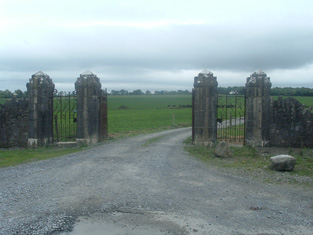
|
| Mill View | A five bay three storey house built about 1800, with some modern additions. At the time of Griffith's Valuation held by Sir Edward Tierney in fee, the buildings were valued at £19+. |

|
| Egmont Villa | A house occupied by Neptune Blood in the mid 19th century. He held the house valued at £19 from Sir Edward Tierney. Restored in the 1980s by Patrick Callaghan and still extant. | |
| Gortmore House | A late 18th century or early 19th century two storey house, the home of the Foote family in the 19th century. Occupied by Mr Thomas Clarke in 1814, by Edward Foote in 1837 and at the time of Griffith's Valuation. He held the house and demesne from Viscount Lismore. It is labelled Gortmore Castle on the 1st edition Ordnance Survey map but as Gortmore House on the later 25-inch edition of the 1890s. It is still extant. |

|
| Ballygiblin | This was the seat of the Becher baronets in the 19th century. Occupied in 1814 by Beecher Wrixon and in 1837 recorded by Lewis as "recently modernised" [William Morrison]. Sir William W. Beecher held Ballygiblin in fee at the time of Griffith's Valuation when it was valued at £52. The seat of Sir John Wrixon Becher in 1894 and still occupied by the Bechers in 1906. In 1944 the Irish Tourist Association Survey reported that it was owned by D.CMurphy and J. Lombard. The report contains detailed background to the Beecher family including the story of Lady Beecher, the actress, Elizabeth O'Neill. This house is now a ruin. |
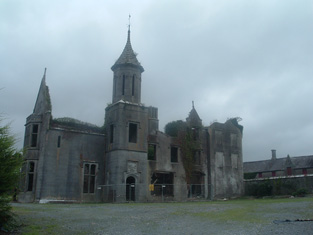
|
| Assolas | Built by the Reverend Francis Gore (died 1748) in the early 18th century and occupied by Philip Oliver circa 1750. This house was the home of the Wrixon family from 1774. Occupied by William Harris in 1814 and by Sir William Wrixon Becher in 1837. Richard Smith was resident in the mid 19th century, holding the property then valued at £25+ from Sir William W. Beecher. Owned and run as a guest house by the Bourke family until 2005. In 2022 it was offered for sale. |

|
| Churchtown House | Located on the Egmont estate Churchtown House was the residence of the Crofts family in the 18th and early 19th centuries. Occupied by George Crofts in 1814 and by the Reverend F.W. Crofts in 1837. By the time of Griffith's Valuation it was owned by Sir Edward Tierney in fee and valued at £44. Later 19th century occupants were Major Trench and John Cowhey. This house is still extant and occupied. |

|
| Bettyville | Charles Bastable lived here in the early years of the 19th century. The house was occupied by John Therry in 1837 and in the mid 19th century, when valued at £11 and held from Anne Westropp. Bettyville was part of the Creagh estate for sale in July 1853 when it was held by the representatives of Thomas Bennett. Very little remains of this house. | |
| Coolnahane | A house situated on Viscount Lismore's estate and occupied by Jeremiah Leane at the time of Griffith's Valuation when it was valued at £10. It is named Coonahane House on both the 1st and 25-inch edition Ordnance Survey maps. A house is still extant at the site. | |
| Killavallig | A building is marked in this townland on the first Ordnance map. A house valued at £14 is recorded at the time of Griffith's Valuation, occupied by Michael R. Mackey and held from Charles Purcell. A house is still extant at this site. | |
| Rathmaher | Originally a Purcell home which was advertised for sale in May 1850. By the time of Griffith's Valuation this house was owned and occupied by Thomas Wise, valued at £33. In 1944 the Irish Tourist Association Survey reported that this house had been built c.1800 by John Purcell originally of Highfort. It was later occupied by Walpole and Smith families. This house is now a ruin. | |
| Gurteenard | A late 18th century house on the Purcell estate, the home of the Collins family in the early 19th century. Occupied by Daniel Bastable in the mid 19th century and held from William Collins. The buildings were valued at £14+. The house was still in Bastable ownership in 1906. |
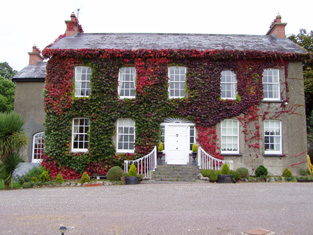
|
| Allowdale | A house valued at almost £12 in the mid 19th century, held by Daniel McCabe from the Earl of Egmont, now a ruin. | |
| Ballyphilibeen | A building is marked on the first Ordnance Survey map in this townland. By the time of Griffith's Valuation Prudence Twinhan was living in a house valued at £14 and held from Thomas Wise with 225 acres. | |
| Lackeel | An early 19th century house valued at £12 was held by Charles Daly in the mid 19th century from Pierce Purcell. This house is still extant. |
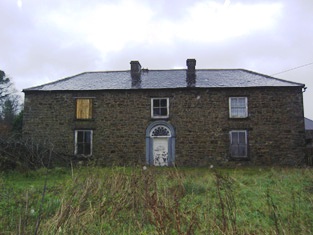
|
| Marybrook | This was originally a tower house with additions from the mid 18th century. Occupied by Edward H. Reardon in the first half of the 19th century and by John O'Connell in the mid 19th century, when it was valued at £11 and held from Bartholomew Gibbings. In the sale rental of May 1860 this house was describes as in "thorough repair" and leased to John Connell for 100 years from 1851. In the 1940s the Irish Tourist Association Survey reported that it was then the residence of the Cronin family. It is still extant and in use. |
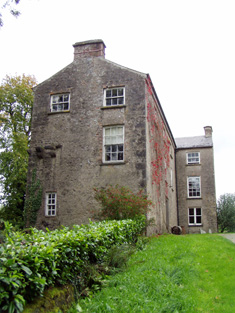
|
| Rossline House | John Noonan held this house valued at £14.15 shillings from Sir Edward Tierney in the mid 19th century. A house and farm are still extant at the site. | |
| Rossline Lodge | Hajba writes that this house was originally built as a hunting lodge for the Earls of Egmont. Patrick Keller held this house valued at £12.10 shillings from Sir Edward Tierney at the time of Griffith's Valuation. It is still occupied. | |
| Castle Park | At the time of Griffith's Valuation this house, valued at £41, was held by Sir Edward Tierney in fee. Still in use as a private residence, in 2014 it was offered for sale. |

|
| Park House | Occupied by Maurice Barry and held from Sir Edward Tierney in the mid 19th century when the buildings were valued at £12+. William F. S. Barry was the occupier in 1906. It is still extant. | |
| Park | A house valued at £18+ in the mid 19th century and held by Sir Edward Tierney in fee. A house is still extant at the site. | |
| Spring Grove | This house was the home of Arthur Bastable in 1814. This house was part of the Creagh estate for sale in July 1853, Christopher Carleton, "a lunatic", was the leasee. Unoccupied at the time of Griffith's Valuation when valued at £9.10 shillings. The representatives of Thomas Harris were the immediate lessors. A house is still extant at the site. | |
| Roskeen | The home of the Power family which was held from the Kingston estate. Pierce Power occupied the house in 1837 and John Power in the early 1850s when the buildings were valued at £24. Arthur Irwin was the occupier of this house in 1906 and it is still lived in. |
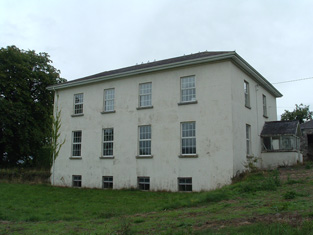
|
| Mountnorth Court | Described by Smith in the mid 18th century as a square building with two wings and fine plantations. In 1786 Wilson refers to it as "the fine and magnificent seat of Lord Lisle, with ample demesnes". This house is described as "in ruins" on the first Ordnance Survey map and modern farm buildings exist at the site now. | |
| Subulter | Leased at the end of the 18th century to James Leahy by the Lloyds. Occupied by John Leahy in 1837 and by Richard Leahy in the early 1850s who held the house valued at £18+ from Thomas Lloyd. Later owned by the Warrens of Codrum House. A new house now stands on the site. | |
| Ballythomas | Originally a Crofts home, leased to the Bullen family by the mid 18th century. Occupied by Robert C. Bullen at the time of Griffith's Valuation. He held the house valued at £12+ and 111 acres in fee. The Crofts appear to have resumed possession in the late 19th century. Home of the O'Connors in the 20th century. |
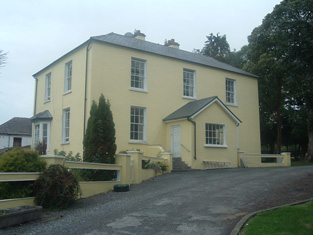
|
| Waterloo | Reputedly built circa 1815 for Henry Longfield, fifth son of John Longfield of Longueville, following his marriage to Mary Powell, heiress of Sea Court, county Cork. At the time of Griffith's Valuation it was held by Henry Longfield in fee and valued at £37. Henry's son John Powell Longfield sold Waterloo to his first cousin Richard Longfield of Longueville who left it to his third son Augustus Henry Longfield. Augustus H. Longfield extended the building. The house was sold to Mr E. W. Hope-Johnstone in 1946. It is still a fine residence. |

|
| Woodpark | This property belonged to the Wrixon family in the 18th century. In 1814 it was occupied by T. Callaghan. In the mid 19th century James Carmichael was in residence. He held it from the representatives of Charles D. Purcell. The buildings were valued at £11.10 shillings. Hajba writes that the Carmichaels later purchased the property from the Purcells. It is still an occupied residence. | |
| Ballyclogh Castle | At the time of Griffith's Valuation Thomas Haines and Son owned a house, corn and flour mill and offices in the townland of Ballyclogh valued at £82. This property was held with 4 acres from the representatives of C.P. Coote and John Wrixon. In 1906 Ballyclogh was occupied by the representatives of Charles P. Coote. The house was located adjacent to a medieval tower house. Both the house and mill are now in ruins. | |
| Blossomfort | Hajba refers to John Wrixon of Blossomfort in 1703. Wilson, writing in 1786, refers to Blossom-fort as the seat of Mr. Wrixon. The present house, occupied by William Bullen in 1814 and by J. Smith in 1837 was built by the Wrixons probably in the early 19th century. In the mid 19th century Blossomfort was the residence of Thomas Haynes who held the property from Benjamin Wrixon. It was valued at £14. Sold by the Wrixons to the Longfields of Longueville, Blossomfort became the residence of their agent, Richard Smith. This house was reconstructed following a fire in the early 1900s and is still extant. |
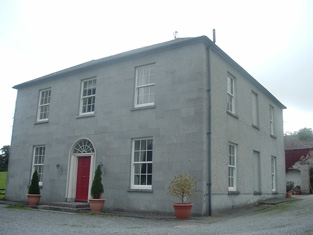
|
| Cecilstown Lodge | A home of members of the Wrixon family in the late 18th and early 19th centuries. Occupied by William Wrixon, father of Sir William Wrixon Becher, in 1837. It was leased to Thomas Heffernan from the 1840s. Valued at £9 in the early 1850s it was later occupied by members of the clergy including the Reverend E.G. Jones, whose widow bought the house in the early 20th century. It was burnt in June 1921 during the War of Independence when it was the residence of the sisters, Esther Jane and Annie Jones. A house, however, still exists at the site. | |
| Dunbarry | This house was the home of James Carey in 1814. Occupied by James Heffernan and held from Sir Edward Tierney at the time of Griffith's Valuation, valued at £18. Sold by the Heffernans in the early 20th century, this house is still extant. The Irish Tourist Association survey mentions Dunbarry as the residence of Denis Kiely in the 1940s. | |
| Tullig | Tullig, located on the Tierney estate and valued at £15.15 shillings, was occupied by Richard Hutch in the early 1850s. The Irish Tourist Association Survey noted that it had belonged to Lord Broghill before the 1641 rebellion and was later granted to the Percevals. It was the residence of John Waterson in the 1940s. It is no longer occupied. |

|
| Burton Park | The original house built by Sir John Perceval and his descendants was burnt down in the Jacobite War 1689-1691. A late Georgian house was built to replace it by the [3rd or 4th] Earl of Egmont which was remodelled in the late 19th century. Burton Park was leased to the Purcells in the 19th century. It was occupied by the Reverend Matthew Purcell in 1814 and 1837 and by his son John in the early 1850s when the house was valued at £34. Passed to the Ryans of Scarteen, county Limerick by marriage in the early 20th century. In the 1940s the Irish Tourist Association Survey noted Burton Park as one of the best examples of eighteenth century domestic architecture in county Cork. Still the home of the Ryan Purcell family. |

|
| Clashganniv | Hajba writes that this house has always been the home of the O'Brien family. Vincent O'Brien, the famous Irish race horse trainer, was born at Clashganniv in 1917. The house is still extant and occupied. At the time of Griffith's Valuation there were two houses in Clashganniv, one valued at £16, was occupied by James Lynch and the other valued at £10 was held in fee by Sir Edward Tierney. | |
| Creggannacourty | Cregane House in Creggannacourty was occupied by the representatives of Sarah Barry and held from Sir Edward Tierney at the time of Griffith's Valuation, when the house was valued at £35. Hajba associates the names Crofts, Hennessy and Hutchins with the house, which in 2002 was the home of the Lynch family. |

|
| Mount Corbitt | Home of the Glover family in the first half of the 19th century. Hajba writes that the Glover's sold their lease to the Anderson family in the early 1850s. In the early 20th century it became the home of the O'Brien family and is still occupied. |

|
| Rath | Smith writes in 1750 that Rath was built by Alderman James French of Cork. Rath house was occupied by Michael Greene in the early 1850s and held from Sir Edward Tierney. It was valued at £12. To the north Rath Cottage (Grid Ref R492 147) was held by Sir Edward Tierney in fee and was valued at £14. This cottage is now a ruin and Rath House although still extant is no longer lived in, a new house having been built on the site. | |
| Jordanstown | A house valued at £14 was occupied at Jordanstown by James Buckley at the time of Griffith's Valuation and held from Sir Edward Tierney. Hajba writes that the Buckleys continued to live at Jordanstown for the rest of the 19th century. Sold to Patrick Walshe in the early 20th century this house is no longer occupied. |

|
| Liskelly | This house situated on the Egmont estate was occupied by Richard Gregg in 1814 and in the early 1850s by David Coghlan who held the house valued at £12 from Sir Edward Tierney. Later Liskelly became the residence of the Nagles and the Brownes. It is no longer occupied. | |
| Bregoge House | A house reputed to incorporate the remains of an old castle. Bregoge Castle was occupied by J. Rogers in 1837 and by John Rogers in the early 1850s. The property was held from the Earl of Egmont and the buildings were valued at £7. The Irish Tourist Association survey in the 1940s notes it as the residence of "Mr.Ryan, a commercial traveller". The house is still a family home. |

|
| Glenville | At the time of Griffith's Valuation Mary Allen occupied Glenvillle, a house valued then at £8. The property was held from the Earl of Egmont. Catherine Cooke daughter of William Allen of Glenville married John Bevan of Camas in 1856. Hajba writes that Glenville belonged to Massy Bevan in the late 19th century. The house was restored in the 20th century and is occupied. |

|
| Egmont House | An early Perceval house situated at Egmont was replaced by the present house in the 18th century. At the time of Griffith's Valuation John Bolster was occupying Egmont House on the Egmont estate. The buildings were valued at £15. Later leased to the Lynch family. The house is extant and under refurbishment in recent years. |

|
| Egmont Lodge | A house was in existence at this location at the time of the first Ordnance Survey but is not named on the map. By the time of Griffith's Valuation it was valued at £14 and occupied by Bartholomew W. Purdon. It is labelled Egmont Lodge on the 25-inch Ordnance Survey map of the 1890s. A house is still extant at the site. |

|
| Egmont Cottage | Egmont Cottage is marked on the first Ordnance Survey map circa 1840. It was the single storied residence of Margaret Magrath in the early 1850s. She held the property from the Earl of Egmont and the buildings were valued at £10. The building has since been extended and is still occupied. Hajba calls this house Egmont Lodge. |

|
| Fort Moylan | Home of the Moylan family on the Egmont estate, occupied by Cornelius Moylan at the time of Griffith's Valuation when the buildings were valued at £10. Still extant and occupied |

|
| Buttevant Castle | Originally a castle of the Barry family, Earls of Barrymore, sold by them in the early 19th century to John Anderson of Fermoy, who restored it as a castellated house and gave it to his eldest son Sir James Anderson. Sir James lived there until the mid 1840s. William Roche occupied the building valued at £37 in the early 1850s. He held the property from Viscount Doneraile and D.R. Browning held a house, flour mill and offices valued at £120 from Roche. The castle had various occupants in the later 19th century and was last occupied in the early 20th century. It is now a ruin. |

|
| Castle View | Located on the Doneraile estate in the mid 19th century this house was occupied by Barry Gregg in 1837 and by the Reverend Cornelius Burkley in the early 1850s when it was valued at £28. This 18th century seven bay house is still a family residence. |
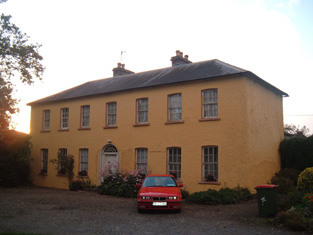
|
| Templemary | A house located on the Purcell estate, occupied by Purcell esq in the 1770s and 1780s, by John Purcell in 1814, by J. O'Leary in 1837 and by Kilner R. Woods in the early 1850s who held it from Wills George Crofts. The house was valued at £23+ at this time. The Fuges occupied the house in the late 19th century and early 20th century. The house was valued at £26 in 1906. The Irish Tourist Association survey in the 1940s described it as "a spacious three-storey house with a cellar". A new house now stands on the site. | |
| Kilpatrick | Hajba writes that Roger Langley leased this property from the Longfields in the mid 18th century. Lewis writes that William J. McCormick, medical doctor,occupied the house in 1837. A boys' school was established at Kilpatrick by the McCormicks. At the time of Griffith's Valuation William J. McCormack held the house valued at almost £10.15 shillings from Christopher Langley. Sir William J. MacCormac was a well known London surgeon, the son of Dr Henry MacCormac of Belfast. The house was occupied until the early 20th century but is now a ruin. | |
| Currymount | Lewis gives J. O'Leary as the proprietor of Currymount in 1837. By the time of Griffith's Valuation Currymount was held by Alexander McCarthy in fee and was valued at £7.10 shillings. Hajba writes that Alexander McCarthy left Currymount to his brother-in-law, James Morrogh, third son of James Morrogh of the city of Cork. The house was considerably extended post Griffith's Valuation. James McCarthy of Currymount owned 259 acres in the 1870s. In the late 19th century Eustace Morrogh Bernard lived at Curraghmore. Bought by the Purcells of Burton Park in the second decade of the 20th century as a dower house and passed by marriage to the Bird family. The Irish Tourist Association Survey refers to it as the seat of Major Bird in the 1940s and also that the Morrogh-Bernard family resided here before going to live at Byblox. |

|
| Altamira | Originally a Smyth house, Altamira became the home of the Purcell family in the late 18th century and remained in their possession for about a century. Occupied by William Purcell in 1814 and 1837 and by his nephew Pierce Purcell at the time of Griffith's Valuation. Pierce held the property from the Earl of Bandon and Lady O'Brien. The house was valued at £34. In the 1940s the Irish Tourist Association Survey noted that Altamira was then the residence of the Hannigan family. |
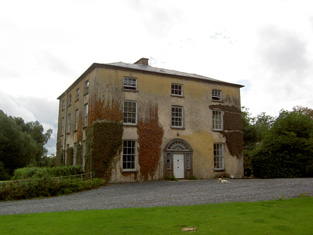
|
| Rockfield | A Nash home in the first half of the 19th century, occupied by Christopher Nash at the time of Griffith's Valuation and held from John James Nugent. The buildings were valued at £7. In the 1940s the Irish Tourist Association Survey noted that this property had once belonged to a family called Badham but was afterwards acquired by the Nashs and that "the present house was probably built by the latter family". A house and substantial farm are still extant at Rockfield. | |
| Aughrim | A home of a branch of the Goold family occupied by George Goold in the early 1850s and held from Henry V. Wrixon. The buildings were valued at £13.10 shillings. George Goold still lived here in the 1870s. The house is occupied. | |
| Teeveeny House | A house valued at £14 held by Michael Cagney from Richard and Jonas Morris in the mid 19th century. His widow Johanna Cagney was still resident in the 1870s. In 1943 the Irish Tourist Association Survey reported that the house had was then occupied by the Condron family. Buildings are still extant at the site. | |
| Moyge | Richard Boles was granted Moyge in 1666. Sir Bernard Burke records the Boles of Devon as still having an interest in Moyge in 1850. At the time of Griffith's Valuation Maurice Newman [Nunan] was the occupier holding the property from the Earl of Bandon. The buildings were valued at £10. 10 shillings. This house no longer exists. | |
| Clonmeen House | Built in 1893 for Stephen Grehan and designed by George Ashlin. This house remained in the possession of the Grehan family until the 1970s. In the 1940s the Irish Tourist Association Survey noted it as the residence of Major Grehan. Late in the twentieth century it functioned as a hotel for some time but has now returned to private ownership. |

|
| Clonmeen Lodge | Hajba writes that this house was the home of Cornelius O'Callaghan in 1750. In 1786 Wilson refers to "Bantyre" as the seat of Mr. Callaghan. Viscount Lismore is recorded as proprietor of Clonmeen in 1814. At the time of Griffith's Valuation Clonmeen Lodge was occupied by George Grehan and held from Viscount Lismore. It was valued at £7+. The Grehans continued to use this house as a secondary residence while their main residence was in Dublin. In 1893 a much larger house, Clonmeen House, was built close to the lodge. In the 1940s the Irish Tourist Association Survey noted "The Lodge, Banteer" as the residence of Jerome O'Callaghan and stated that the house had originally been built by the Nash family as a fishing lodge. A building is still extant at the site. | |
| Highfort | The Purcells originally lived in a thatched house located a short distance from the present building and this house was associated with a Whiteboy attack. John Purcell was knighted for his defense of his property. The later house was built by his son, Dr. Richard Purcell, circa 1837 and Dr Richard's wife, Mrs Eliza Purcell, was resident in the early 1850s when the house was valued at £21+ and held from Pierce Purcell. Mrs Eliza Purcell was the second daughter of Pierce Purcell of Altimira. Occupied by Daniel Stephen Wigmore in the early 20th century. The Irish Tourist Association Survey of the 1940s noted that it was then the residence of the O'Sullivan family. It is no longer extant. | |
| Springville | Originally owned by a family named Minton who sold the property to the Wises of Cork city in the 1840s. It was then leased to Charles Daly who occupied the house valued at £5 at the time of Griffith's Valuation. Grove White writes that Daly spent a large sum of money reconstructing the house. Later occupied by O'Briens and Bolsters, still extant and lived in. |

|
| Copsetown Abbey | This building is named Fitz Urse Lodge on the first edition Ordnance Survey map. It was valued at £6 occupied and held in fee by Richard Beere in the mid 19th century. Hajba writes that William Fitzgibbon, a Cork draper, bought the house in 1851 and that it was the home of the O'Connors in the 20th century. The house was known as Copsetown Abbey by the end of the 19th century. |
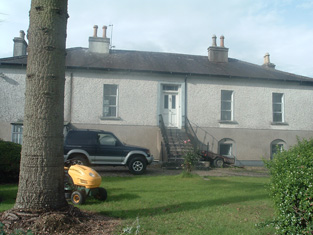
|
| Farm Hill | In the mid 19th century occupied by Mrs Hannah Goold, valued at £13 and held from Richard and Jonas Morris. This house is marked on the first Ordnance Survey map and a building is still located at the site. | |
| Glenview Cottage | In 1786 Wilson refers to a house in the vicinity of Egmont as "Glenfield", the seat of Mr. Wrixon. This may be the property marked on the 1st edition Ordnance Survey map as Glenview Cottage. At the time of Griffith's Valuation, this house was leased by Daniel Murphy from the Egmont estate and valued at £10. A house is still extant at the site. | |
| Gortmore Cottage | At the time of Griffith's Valuation, Gortmore Cottage was occupied by Roger O'Callaghan, leasing from Reverend Phillip Townsend, when the house was valued at £11. In the 1940s the Irish Tourist Association Survey noted that the original house had burnt down in 1911 and a two-storey house was then occupying the site. |

